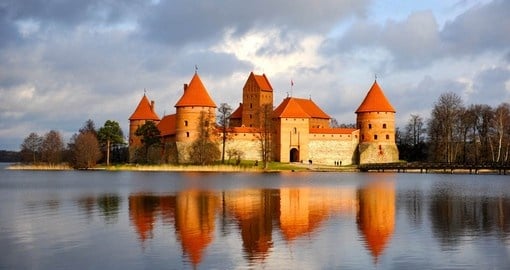Lithuania History
The origin of the nation and the development of its culture were strongly influenced by foreign occupation of the country and are the result of the perceived need of the people to preserve something of their own. Even when the national language was banned and reading or writing of books in the native tongue was forbidden, people were determined to spread their heritage and share their traditions.
The first Lithuanian state was established in 1230 after Duke Mindaugas united the tribes and lands in the area. Further credit for the early development of this goes to Gediminas, the principal unifier of the territory from the Baltic to the Black Sea. He was one of the first leaders to instill in the people the spirit of nationhood, and the main street of Vilnius, with the parliament building at one end and the national cathedral at the other, bears his name. In the fourteenth and fifteenth centuries, the Grand Duke of Lithuania married Queen Jadvyga of Poland to create the confederation called Rzeczpospolita.
In the late nineteenth and early twentieth centuries, literacy became a valuable tool in the development of cultural and national identity. Although it was illegal, people continued to read the literature of the national movement. Literacy rates were considerably higher than those in Russia and contributed greatly to the rise of national identity.
In 1905, the Great Lithuanian Assembly gathered to discuss the Lithuanian nation. It was agreed that the country should fight for and be granted autonomy, whether within Czarist Russia or independent of it. The intelligentsia, with help from the Lithuanian Academy of Sciences, drafted a document making demands for the future of the Lithuanian state. Among those demands were autonomy, equal rights for aliens within Russia, the construction of Lithuanian schools and freedom of worship.
In 1918, Lithuania formally declared independence, which was granted by both Germany and the Soviet Union. While lasting independence would not come until nearly a century later (the Soviet Union occupied the nation in 1940, and the Nazis in 1941), the fact that schools resumed teaching in Lithuanian and people around the country assembled more readily to discuss their views was significant.
The period from 1941 to 1944 saw the countryside destroyed and almost all of the Jewish population (up to 250,000) annihilated. The period under Stalin, from 1945 to 1953, made the people more determined to put an end to the repression their country had experienced for so long. Tens of thousands of people, including most intellectuals, were deported to Siberia for being educated or being involved in intellectual circles, and many others fled.
At the beginning of 1989, the popular movement Sajudis announced a platform for the complete restoration of Lithuanian sovereignty. This led to closer monitoring by the Soviet Union and increased Soviet troop movements in Lithuania in an effort to maintain order. The remainder of 1989 and most of 1990 were marked by deliberations both between the Soviet government and the Lithuanian popular movement and among different parties within those constituencies. In March 1990, Lithuania declared full reestablishment of independence from the Soviet Union
In late 1990 a popularist rally to help Lithuanians evade the Red Army draft was organized, and the Soviet government decided to deal with "the Lithuanian problem" once and for all. The Lithuanian Communist Party secretary had claimed that the human rights of non-Lithuanian citizens in the country were being violated and encouraged Soviet intervention. In January 1991, KGB plants posing as Russian workers stormed the parliament. A few days later, in what was described as precautionary measures to protect the human rights of Soviet citizens, Soviet troops gathered around the Parliament, the Lithuanian Press House, and the Vilnius television tower
Two weeks after the episode, Mikhail Gorbachev appointed a delegation to negotiate with Baltic leaders. Although troop movements continued for much of the year, especially in Vilnius and along the border with Kaliningrad, it was obvious that the Soviet presence was finished. In September 1991, the Soviet Union recognized Lithuania as an independent republic. Later that month, Lithuania became a member of the United Nations—three months before the demise of the Soviet Union. In 1993, the first directly elected president was chosen.
Lithuania Travel Information
At Goway we believe that a well-informed traveller is a safer traveller. With this in mind, we have compiled an easy to navigate travel information section dedicated to Luithuania.
Learn about the history and culture of Lirthuania, the must-try food and drink, and what to pack in your suitcase. Read about Lithuania’s nature and wildlife, weather and geography, along with 'Country Quickfacts' compiled by our travel experts. Our globetrotting tips, as well as our visa and health information, will help ensure you're properly prepared for a safe and enjoyable trip. The only way you could possibly learn more is by embarking on your journey and discovering Lithuania for yourself. Start exploring… book one of our Lithuania tours today!
Get a Trip Quote Order a Brochure

















